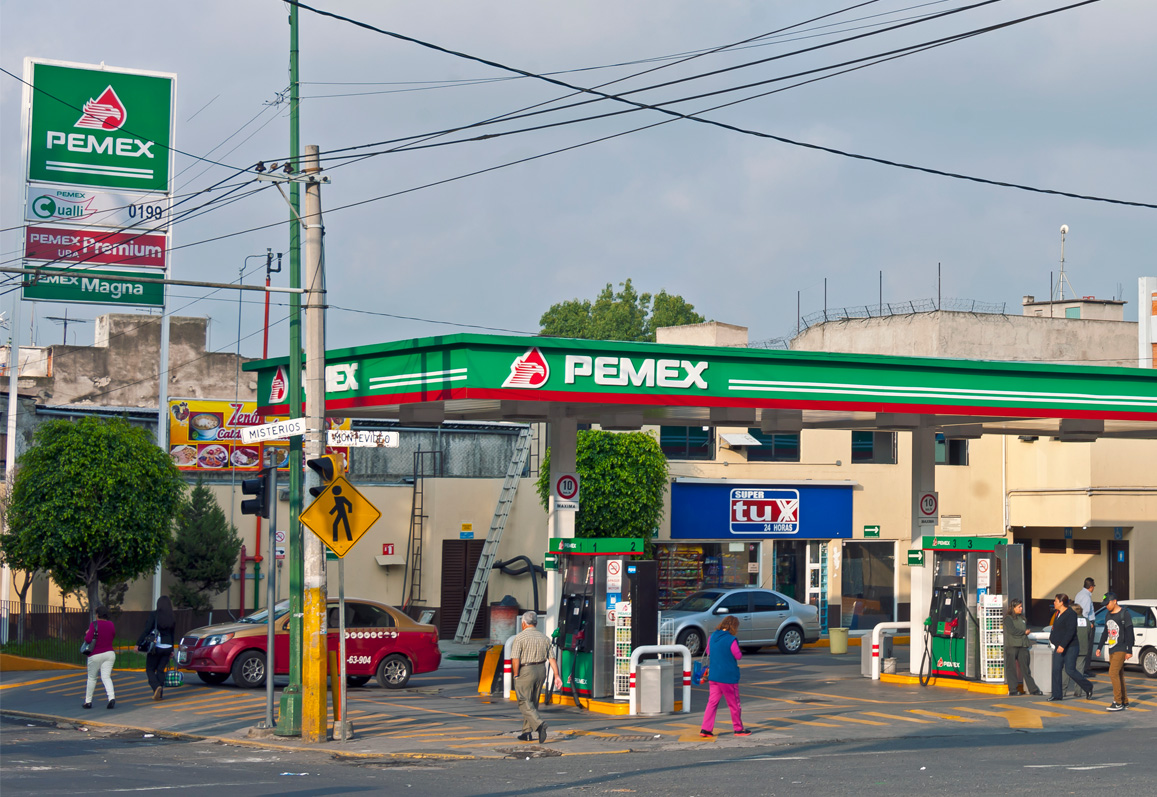 So here we are, summer is over (or almost over if you’re an optimist) and we are sitting in front of our screens reminiscing about hot sunny days (at least I do)! There is no doubt, however: a lot happened in the world of politics and economics in the past three months. The escalation of the US-China trade war, the run on the Turkish lira, the (successful?) conclusion of the Greek bailout – these are all examples of major economic developments that took place during the summer months, and which we will be sure to discuss in some detail in future blogs. Today, however, I will introduce a topic that I am very interested in as a researcher: the liberalisation of energy markets in developing countries and, in particular, Mexico.
So here we are, summer is over (or almost over if you’re an optimist) and we are sitting in front of our screens reminiscing about hot sunny days (at least I do)! There is no doubt, however: a lot happened in the world of politics and economics in the past three months. The escalation of the US-China trade war, the run on the Turkish lira, the (successful?) conclusion of the Greek bailout – these are all examples of major economic developments that took place during the summer months, and which we will be sure to discuss in some detail in future blogs. Today, however, I will introduce a topic that I am very interested in as a researcher: the liberalisation of energy markets in developing countries and, in particular, Mexico.
Why Mexico? Well, because it is a great example of a large developing economy that has been attempting to liberalise its energy market and reverse price setting and monopolistic practices that go back several decades. Until very recently, the price of petrol in Mexico was set and controlled by Pemex, a state monopolist. This put Pemex under pressure since, as a sole operator, it was responsible for balancing growing demand and costs, even to the detriment of its own finances.
The petrol (or ‘gasoline’) price liberalisation started in May 2017 and took place in stages – starting in the North part of Mexico and ending in November of the same year in the central and southern regions of the country. The main objective was to address the notable decrease in domestic oil production that put at risk the ability of the country to meet demand; as well as Mexico’s increasing dependency on foreign markets affected by the surge of the international oil price. The government has spent the past five years trying to create a stronger regulatory framework, while easing the financial burden on the state and halting the decline in oil reserves and production. Unsurprisingly, opening up a monopolistic market turns out to be a complex and bumpy process.
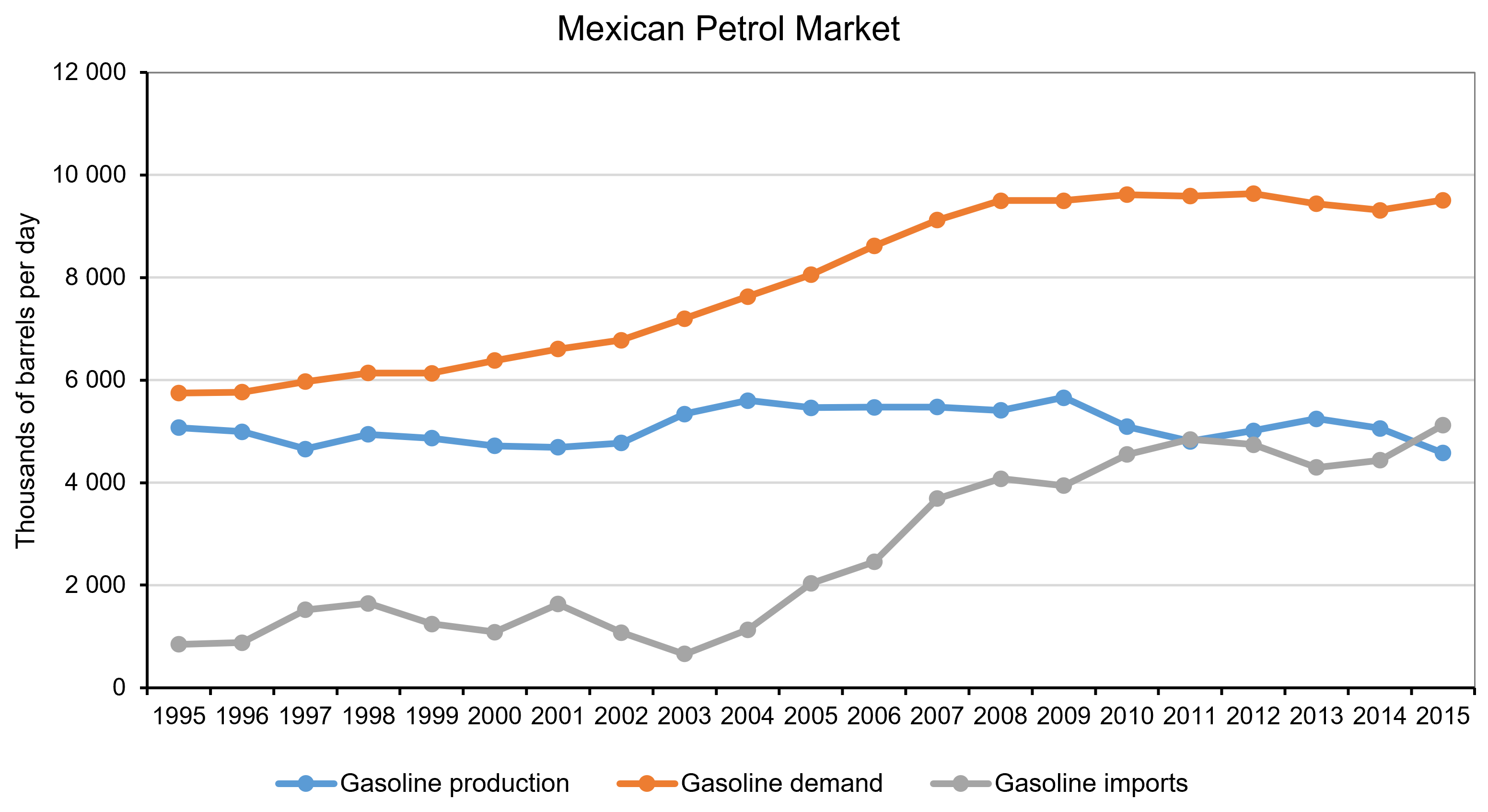 Source: Author’s calculations using data from the Energy Information Bank, Ministry of Energy, Mexico
Source: Author’s calculations using data from the Energy Information Bank, Ministry of Energy, Mexico
Despite all the reforms, retail petrol prices have kept rising. Although part of this price rise is demand-driven, an increasing number of researchers highlight the significance of the distribution of oil-related infrastructure in determining price outcomes at the federal and regional (state) level. Saturation and scarcity of both distribution and storage infrastructure are probably the two most significant impediments to opening the sector up to competition (Mexico Institute, 2018). You see, the original design of these networks and the deployment of the infrastructure was not aimed at maximising efficiency of distribution – the price was set by the monopolist and, in a way that was compliant with government policy (Mexico Institute, 2018). Economic efficiency was not always part of this equation. As a result, consumers located in better-deployed areas were subsidising the inherent logistics costs of less ‘well endowed’ regions by facing an artificially higher price than they would have in a competitive market.
But what about now? Do such differences in the allocation of infrastructure between regions lead to location-related differences in the price of petrol? If so, by how much? And, what policies should the government pursue to address such imbalances? These are all questions that I explore in one of my recent working papers titled ‘Widening the Gap: Lessons from the aftermath of the energy market reform in Mexico’ (with Hugo Vallarta) and I will be sharing some of the answers with you in a future blog.
Articles
Data
Questions
- Are state-owned monopolies effective in delivering successful market outcomes? Why yes, why no?
- In the case of Mexico, are you surprised about the complexities that were involved with opening up markets to competition? Explain why.
- Use Google to identify countries in which energy markets are controlled by state-owned monopolies.
 In the UK, petrol prices have fallen significantly over the past couple of years and currently stand in some places at below £1 per litre. For UK residents, this price is seen as being cheap, but if we compare it to prices in Venezuela, we get quite a different picture. Prices are increasing here for the first time in 20 years from $0.01 per litre to $0.60 per litre – around 40 pence, while lower grade petrol increases to $0.10 per litre.
In the UK, petrol prices have fallen significantly over the past couple of years and currently stand in some places at below £1 per litre. For UK residents, this price is seen as being cheap, but if we compare it to prices in Venezuela, we get quite a different picture. Prices are increasing here for the first time in 20 years from $0.01 per litre to $0.60 per litre – around 40 pence, while lower grade petrol increases to $0.10 per litre.
Venezuela has oil fields in abundance, but has not used this natural resource to its full potential to bolster the struggling economy. The price of petrol has been heavily subsidised for decades and the removal of this subsidy is expected to save around $800 million per year.
 This will be important for the economy, given its poor economic growth, high inflation and shortages of some basic products. Venezuela relies on oil as the main component of its export revenues and so it has been hit very badly, by such low oil prices. The money from this reduced subsidy will be used to help social programmes across the country, which over time should help the economy.
This will be important for the economy, given its poor economic growth, high inflation and shortages of some basic products. Venezuela relies on oil as the main component of its export revenues and so it has been hit very badly, by such low oil prices. The money from this reduced subsidy will be used to help social programmes across the country, which over time should help the economy.
In addition to this reduced subsidy on petrol prices, Venezuela’s President has also taken steps to devalue the exchange rate. This will help to boost the economy’s competitiveness and so is another policy being implemented to help the economy. However, some analysts have said that these changes don’t go far enough, calling them ‘small steps’, ‘nowhere near what is required’ and ‘late and insufficient’. The following articles consider the Venezuelan crisis and policies.
Venezuela raises petrol price for first time in 20 years BBC News (18/02/16)
Venezuela president raises fuel price by 6,000% and devalues bolivar to tackle crisis The Guardian, Sibylla Brodzinsky (18/02/16)
Venezuela’s Maduro devalues currency and raises gasoline prices Financial Times, Andres Schipani (18/02/16)
Venezuela hikes gasoline price for first time in 20 years The Economic Times (18/02/16)
Venezuela hikes fuel prices by 6000%, devalues currency to tackle economic crisis International Business Times, Avaneesh Pandey (18/02/16)
Market dislikes Venezuela reforms but debt rallies again Reuters (18/02/16)
Questions
- Why are oil prices so important for the Venezuelan economy?
- How will they affect the country’s export revenues and hence aggregate demand?
- Inflation in Venezuela has been very high recently. What is the cause of such high inflation? Illustrate this using an aggregate demand/aggregate supply diagram.
- How will a devaluation of the currency help Venezuela? How does this differ from a depreciation?
- Petrol prices have been subsidised in Venezuela for 20 years. Show how this government subsidy has affected petrol prices. Now that this subsidy is being reduced, how will this affect prices – show this on your diagram.
- Why are many analysts suggesting that these policies are insufficient to help the Venezuelan economy?
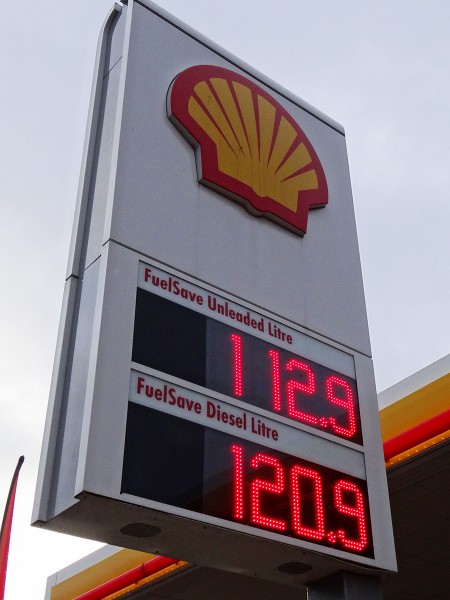 Oil prices have been plummeting in recent months. Indeed, many commentators are saying that this is the major economics news story of 2014. In June 2014 Brent crude was around $112 per barrel. By December the price has fallen to around $60 – a fall of 46%. But what are the implications for fuel prices?
Oil prices have been plummeting in recent months. Indeed, many commentators are saying that this is the major economics news story of 2014. In June 2014 Brent crude was around $112 per barrel. By December the price has fallen to around $60 – a fall of 46%. But what are the implications for fuel prices?
Just because the crude oil price has fallen by 46%, this does not mean that prices at the pump should do the same. Oil is priced in dollars and the pound has depreciated against the dollar by just over 7% since June, from around £1 = $1.69 to around £1 = $1.57. Thus in sterling terms, crude oil has fallen by only 42%.
More significantly, the cost of crude is a relatively small percentage of the price of a litre of petrol. At a price of 132p per litre (the July average price), crude accounted for around 27% of the price, or around 36p per litre. At a price of 114p per litre, the price in late December, crude accounts for around 19% of the price, or around 21.5p per litre. The largest element of price is fuel duty, which is charged at a flat rate of 57.95p per litre. In addition there is VAT at 20% of the pre-VAT price (or 16.67% of the retail price). Finally there are the refining, distribution and retail costs and margins, but these together account for only around 16p per litre.
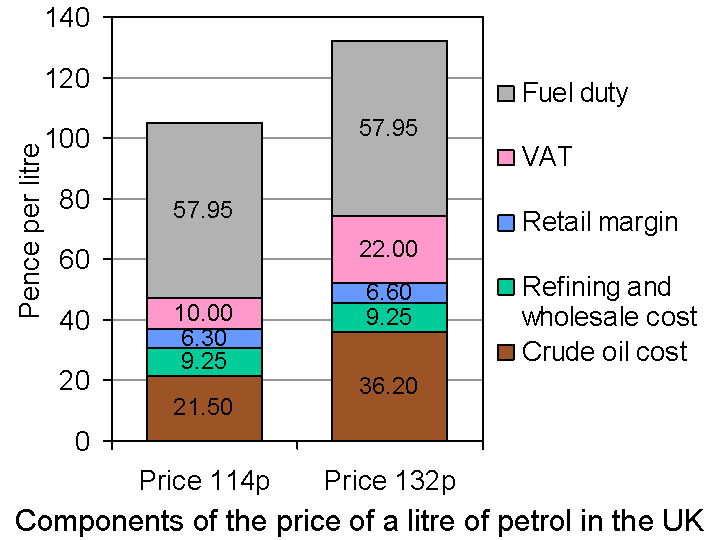 What this means is that the 46% cut in oil prices has led to a cut in petrol prices of only around 14%. If petrol prices were to reach £1 per litre, as some commentators have forecast, crude oil prices would have to fall to under $40 per barrel.
What this means is that the 46% cut in oil prices has led to a cut in petrol prices of only around 14%. If petrol prices were to reach £1 per litre, as some commentators have forecast, crude oil prices would have to fall to under $40 per barrel.
Although petrol and diesel prices have fallen by a smaller percentage than oil prices, this still represents a significant cut in motoring and transport costs. It also represents a significant cut in costs for the petrochemical industry and other industries using large amounts of oil.
For oil-importing countries this is good news as the fall in the oil price represents an increase in real incomes. For oil importing countries, and especially those such as Russia and some OPEC countries where oil constitutes a large proportion of their exports, it is bad news. We explore these effects in Part 2.
Videos
 UK petrol prices hit four-year low BBC News, John Moyland (10/12/14)
UK petrol prices hit four-year low BBC News, John Moyland (10/12/14)
 Petrol prices plunge ahead of Christmas holidays Belfast Telegraph (19/12/14)
Petrol prices plunge ahead of Christmas holidays Belfast Telegraph (19/12/14)
 Petrol price plummet – could fuel drop to below a pound a litre in the New Year? Channel 5 News on YouTube (17/12/14)
Petrol price plummet – could fuel drop to below a pound a litre in the New Year? Channel 5 News on YouTube (17/12/14)
Articles
UK motorists benefit from petrol price drop Financial Times, Michael Kavanagh (23/12/14)
Petrol to drop to £1 a litre, says Goldman Sachs The Telegraph, Szu Ping Chan (9/12/14)
Oil prices: How low will they go in 2015? International Business Times, Shane Croucher (22/12/14)
Plummeting oil price may lead to petrol falling below £1 a litre RAC news (17/12/14)
Pump Prices: Cheap Petrol Comes With A Warning Sky News (19/12/14)
Data and information
Fuel prices in Europe Drive Alive (20/12/14)
Weekly road fuel prices Department of Energy & Climate Change (23/12/14)
Prices at the pump – why are they falling and will this continue? ONS (18/12/14)
Fuel Prices Explained RAC
UKPIA Statistical Review 2014 United Kingdom Petroleum Industry Association
Questions
- Why does the price of petrol fluctuate less in percentage terms than the price of crude oil?
- What factors will affect whether UK petrol prices fall to £1 per litre?
- If crude oil prices fell by 20%, in which of these two cases would there be a bigger percentage fall in petrol prices: (a) petrol price currently 140p; (b) petrol price currently 110p? Explain.
- Distinguish between a specific tax and an ad valorem tax. Which of these is (a) fuel duty; (b) VAT? Illustrate your answer with a supply and demand diagram.
- What determines the price elasticity of demand for petrol and diesel? Is the long-run elasticity likely to be higher or lower than the short-run elasticity? Explain.
- Distinguish between demand-pull and cost-push inflation. Given that oil price changes are correlated to inflation, would you characterise recent falls in inflation as reductions in demand-pull or cost-push pressures, or both: (a) in a specific oil-importing country; (b) globally?
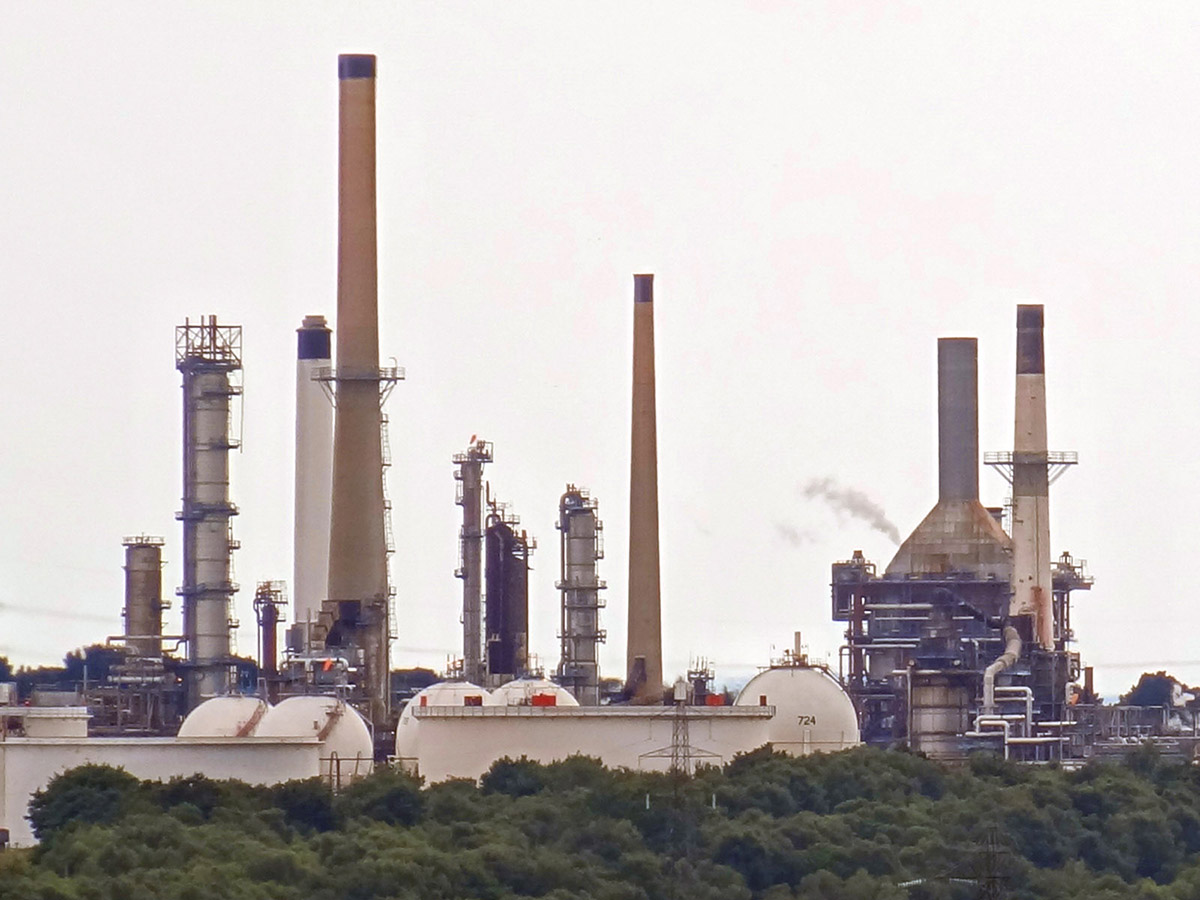 A big expenditure for many households is petrol. The price of petrol is affected by various factors, but the key determinant is what happens in the oil market. When oil prices rise, this pushes up the price of petrol at the pumps. But, when they fall, do petrol prices also fall? That is the question the government is asking.
A big expenditure for many households is petrol. The price of petrol is affected by various factors, but the key determinant is what happens in the oil market. When oil prices rise, this pushes up the price of petrol at the pumps. But, when they fall, do petrol prices also fall? That is the question the government is asking.
The price of oil is a key cost of production for companies providing petrol and so when oil prices rise, it shifts the supply curve up to the left and hence prices begin to increase. We also see supply issues developing with political turmoil, fears of war and disruption and they have a similar effect. As such, it is unsurprising that petrol prices rise with concern of supply and rising costs. But, what happens when the opposite occurs? Oil prices have fallen significantly: by a quarter. Yet, prices at the pump have fallen by around 6%. This has caused anger amongst customers and the government is now urging petrol retailers to pass their cost savings from a lower price of oil onto customers. Danny Alexander, Chief Secretary to the Treasury said:
“I believe it’s called the rocket-and-feather effect. The public have a suspicion that when the price of oil rises, pump prices go up like a rocket. But when the price of oil falls, pump prices drift down like a feather … This has been investigated before and no conclusive evidence was found. But even if there were a suspicion it could be true this time it would be an outrage.”
However, critics suggest that tax policy is partly to blame as 63% of the cost of petrol is in the form taxation through fuel duty and VAT. Therefore even if oil prices do fall, the bulk of the price we pay at the pumps is made up of tax revenue for the government. Professor Stephen Glaister, director of the RAC Foundation said:
“It’s a simple story. Before tax we have just about the cheapest petrol and diesel in Europe. After tax we have just about the most expensive … It’s right to keep the pressure on fuel retailers but if drivers want to know what’s behind the high pump prices of recent years all they have to do is follow the trail back to the Treasury … if ministers are serious about reducing fuel prices further then they should cut duty further.”
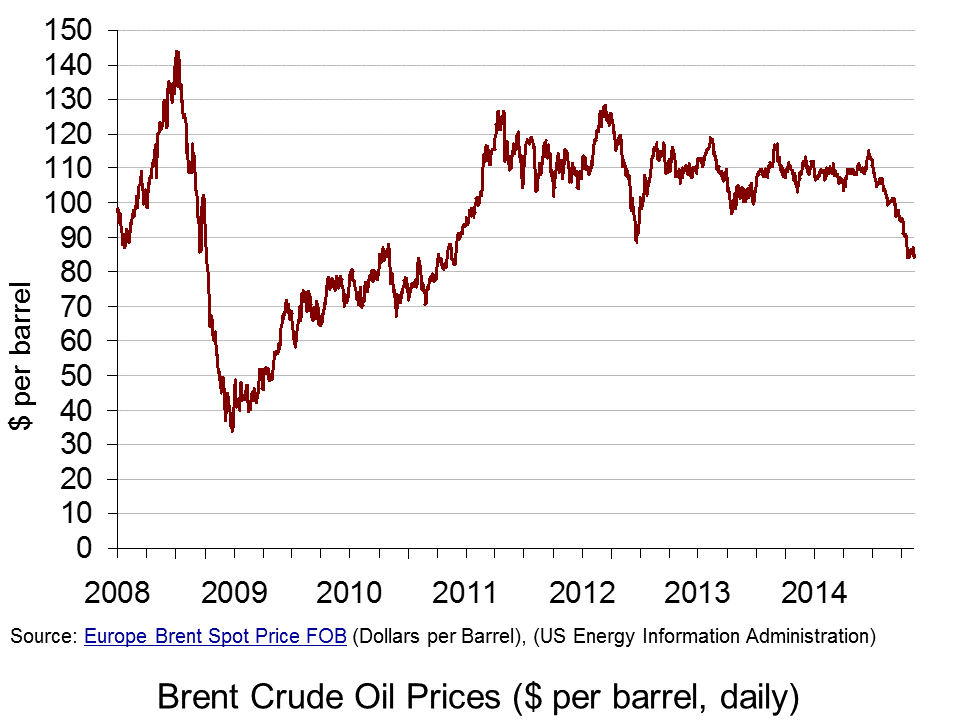 (Click here for a PowerPoint of the chart.)
(Click here for a PowerPoint of the chart.)
However, even taking out the fuel duty and VAT, Arthur Renshaw, an analyst at Experian has said that the actual price of petrol has fallen by 21% since last year. Still, a much bigger decrease than we have seen at the pumps. One further reason for this may be the fact that dollars is the currency in which oil is traded. The pound has been relatively weak, falling by almost 7% over the past few months and hence even though the price of oil has fallen, the effect on UK consumers has been less pronounced.
The big supermarkets have responded to government calls to cut petrol prices, but how much of this cut was influenced by the government and how much was influenced by the actions of the other supermarkets is another story. A typical oligopoly, where interdependence is key, price wars are a constant feature, so even if one supermarket cut petrol prices, this would force others to respond in kind. If such price wars continue, further price cuts may emerge. Furthermore, with oil production still at such high levels, this market may continue to put downward pressure on petrol prices. Certainly good news for consumers – we now just have to wait to see how long it lasts, with key oil producing countries, such as Russia taking a big hit. The following articles consider this story.
Articles
Supermarkets cut fuel prices again The Telegraph, Nick Collins (6/11/14)
Petrol retailers urged to cut prices in line with falling oil costs The Guardian, Terry Macalister (6/11/14)
Supermarkets cut petrol prices after chancellor’s criticism Financial Times, Michael Kavanagh (6/11/14)
Governent ‘watching petrol firms’ Mail Online (6/11/14)
Our horrendous tax rates are the real reason why petrol is still so expensive The Telegraph, Allister Heath (6/11/14)
Osborne ‘expects’ fuel price drop after fall in oil price BBC News (6/11/14)
Danny Alexander tells fuel suppliers to pass on oil price cuts to drivers The Telegraph, Peter Dominiczak (5/11/14)
Further UK fuel cuts expected as pound strengthens The Scotsman, Alastair Dalton (6/11/14)
Data
Spot oil prices Energy Information Administration
Weekly European Brent Spot Price Energy Information Administration (Note: you can also select daily, monthly or annual.)
Annual Statistical Bulletin OPEC
Questions
- Using a supply and demand diagram, illustrate the impact that a fall in the price of oil should have on the price of petrol.
- What is the impact of a tax on petrol?
- Why is petrol a market that is so heavily taxed? You should think about the incidence of taxation in your answer.
- Why does the strength of the pound have an impact on petrol prices in the UK and how much of the oil price is passed onto customers at the pumps?
- Does the structure of the supermarket industry help customers when it comes to the price of petrol? Explain your answer.
- Militant action in some key oil producing countries has caused fears of oil disruption. Why is that oil prices don’t reflect these very big concerns?
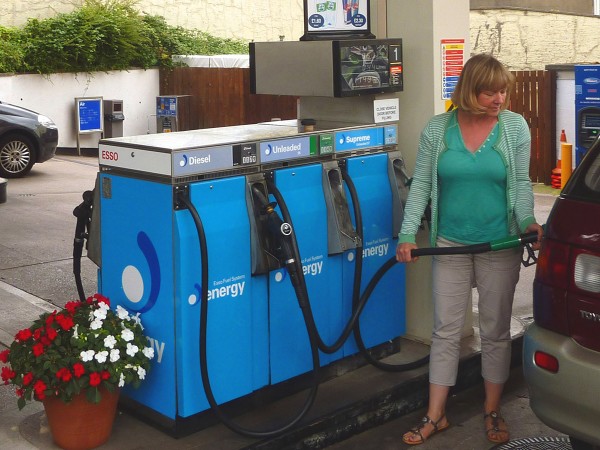 The price of road fuel is falling. Petrol and diesel prices in the UK are now at their lowest level since February 2011. The average pump price for a litre of unleaded petrol has fallen to 130.44p in November – down nearly 8p per litre since September.
The price of road fuel is falling. Petrol and diesel prices in the UK are now at their lowest level since February 2011. The average pump price for a litre of unleaded petrol has fallen to 130.44p in November – down nearly 8p per litre since September.
According to the AA, the reduction in price equates to a fall in the average monthly expenditure on petrol of a two-car family of £14.49 – down from £252.54 to £238.05. This saving can be used for spending on other things and can thus help to boost real aggregate demand. The fall in price has also helped to reduce inflation.
But will lower fuel prices lead to a rise in fuel consumption? In other words, will some of the savings people make when filling up be used for extra journeys? If so, how much extra will people consume? This, of course depends on the price elasticity of demand.
The following articles explain why the price of road fuel has fallen and look at its consequences.
Webcast
 Good news for motorists as fuel prices fall in the East ITN (22/11/13)
Good news for motorists as fuel prices fall in the East ITN (22/11/13)
Articles
November fuel price update Automobile Association (22/11/13)
Finally there is good news for motorists as petrol prices hit lowest level since 2011 The Telegraph, Steve Hawkes (22/11/13)
Petrol prices fall to lowest level for almost three years as strong pound gives motorists relief on the forecourt This is Money, Lee Boyce (22/11/13)
Falling petrol prices boost motorists The Guardian (22/11/13)
Data
Weekly road fuel prices Department of Energy & Climate Change
Europe Brent Spot Price US Energy Information Administration
Spot exchange rate, US $ into Sterling Bank of England
Questions
- Why have the prices of petrol and diesel fallen?
- Illustrate the fall in price of road fuel on a demand and supply diagram.
- How does the size of the fall in price depend on the price elasticity of demand for road fuel?
- If a fall in price results in a fall in expenditure on road fuel, what does this tell us about the price elasticity of demand?
- Why may the price elasticity of demand for road fuel be more elastic in the long run than in the short run?
- If a motorist decides to spend a fixed amount of money each week on petrol, irrespective of the price, what is that person’s price elasticity of demand?
- Using the links to data above, find out what happened to the dollar price of sterling and the Brent crude oil price between September and November 2013.
- How do changes in the exchange rate of the dollar to the pound influence the price of road fuel?
- If the price of oil fell by x per cent, would you expect the price of road fuel to fall by more or less than x per cent? Explain.
- Why do petrol prices vary significantly from one location to another?
 So here we are, summer is over (or almost over if you’re an optimist) and we are sitting in front of our screens reminiscing about hot sunny days (at least I do)! There is no doubt, however: a lot happened in the world of politics and economics in the past three months. The escalation of the US-China trade war, the run on the Turkish lira, the (successful?) conclusion of the Greek bailout – these are all examples of major economic developments that took place during the summer months, and which we will be sure to discuss in some detail in future blogs. Today, however, I will introduce a topic that I am very interested in as a researcher: the liberalisation of energy markets in developing countries and, in particular, Mexico.
So here we are, summer is over (or almost over if you’re an optimist) and we are sitting in front of our screens reminiscing about hot sunny days (at least I do)! There is no doubt, however: a lot happened in the world of politics and economics in the past three months. The escalation of the US-China trade war, the run on the Turkish lira, the (successful?) conclusion of the Greek bailout – these are all examples of major economic developments that took place during the summer months, and which we will be sure to discuss in some detail in future blogs. Today, however, I will introduce a topic that I am very interested in as a researcher: the liberalisation of energy markets in developing countries and, in particular, Mexico. Source: Author’s calculations using data from the Energy Information Bank, Ministry of Energy, Mexico
Source: Author’s calculations using data from the Energy Information Bank, Ministry of Energy, Mexico






